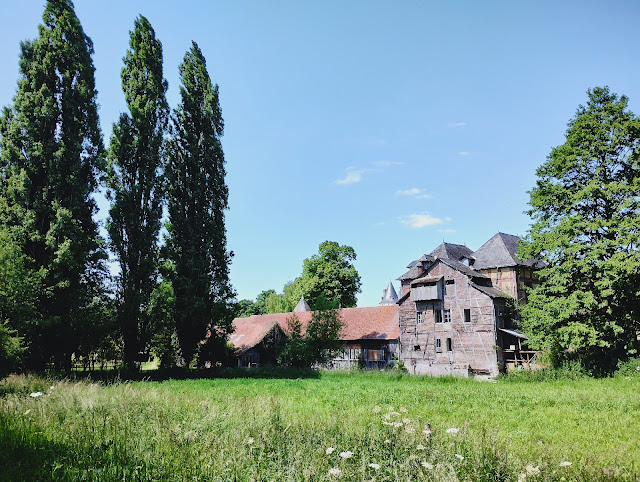Our original idea was to arrive in Dieppe then head straight for Brittany, maybe breaking the journey somewhere between Avranches and Rennes. Instead we ended up hanging around Normandy for almost a week waiting for the antibiotics to sort me out. Maybe we never really had a clear plan to begin with, just a vague idea we might visit some unfamiliar places on the north coast of Brittany then revisit a few old haunts in the west and south. Given we now had fewer days in the region, we were going to have to choose either to go south to Morbihan or head west towards one of Brittany's pointy bits. Morbihan's translucence versus the far west's wild headlands. No competition! The wild west won.
Our plan was to drive around the Quimper rocade then head towards Cornuaille, Finisterre's Breton heartland. This is one of those places that felt half familiar even before we first visited it in our mid-twenties. Some places carry so many preconceptions that arriving can fee like deja vu. For example, when we first visited New York the Manhattan streets felt oddly familiar because of all the sassy NYC comedies we had watched over the previous decades - Breakfast at Tiffany's, the run of Woody Allen films from Annie Hall to Hannah and her Sisters and Nora Ephraim's romantic comedies - When Harry Met Sally, You've got Mail and Sleepless in Seattle's schmaltzy conclusion .
I grew up before the era of daytime TV, in a household where the 'Home Service' was the soundtrack to my childhood. My first encounter with 'Finisterre' was as a place of mystery, along with Dogger, Malin and Rockall, incanted daily on the 'shipping forecast'.
The first time I realised that Finisterre was a territory rather than a featureless stretch of ocean was when I came across it as the title of a poem in Sylvia Plath's posthumous collection 'Crossing the Water' published in 1972. It was was given to me by a friend,. The message inside, "happy grants cheque day, happy getting better week!" dates its acquisition precisely, to late April 1975. The gist of the dedication reminds me that I was emerging from a dark time, especially attuned to the trajectory of Plath's haunting poems, which with the benefit of hindsight was not a good place to be in at all. 'Finisterre' resonated with me immediately and the name acquired a connotation of melancholy as well as wildness. Add to that, my vague predilection towards the 'celtic twilight' derived from the music of Alan Stivel, the region's association with Arthurian legend and my own sense of having a 'celtic genes' inherited from my Irish and Scottish forbears - all this ensured my expectations of Brittany were ludicrously romanticised well before we first disembarked in Roscoff in 1977.
However, the place did live up to these preconceived notions - Brittany's strong regional culture was inescapable. On our visits four decades ago we often happened upon a local 'Fest Noz' where people donned local costume and celebrated the areas unique traditional dance accompanied by bagpipes and bombarde. In the far west the landscape's spectacular cliffs, sweeping bays and big skies felt remote, empty and slightly disconnected from modernity.
Today it doesn't feel quite so distinctive. It's tricky to know whether the place has changed or I have, probably a bit of both. In terms of wealth, of France's thirteen regions Brittany comes fifth, one place below Provence Cote d'Azur in terms of GDP per capita. I doubt this was the case four decades ago. Undoubtedly the area is much busier and prosperous looking. Most towns are ringed by recent housing developments, industrial estates and shopping centres.
This has to be a good thing but development does comes at a cost, resulting in a loss of localism. The place feels less unique than I remembered it. Also, the sixty something me is less given to romantic notions anyway, considerably more skeptical than I was in my twenties, so perception plays its part too.
We ground to a halt on the outskirts on Concarneau, no particular reason for the traffic jam other than an 11.45am 'l'heure du déjeuner' dash for home. Snails pace traffic continued all the way to Quimper and around Douarnenez too. Only when we reached the minor roads on Cap Sizun did it become less
frenetic. The far end of Cap Sizun is two pronged, a bit like a toasting fork, The Pointe de Raz is the more celebrated of the prongs with a spectacular cliffs, an iconic lighthouse and an enormous statue, 'Notre-Dame des Naufragés', commemorating sailors lost at sea. Though the place is not actually the most westerly point in France it has purloined that role and become a must visit destination, a bit like Lands End.
The promontory is immediately recognisable as the place Sylvia Plath wrote about. Having visited the spot years ago on some previous trip or other we felt no particular need to rush back. Instead we headed towards Cap Sizun's other 'prong', the Pointe du Van, situated about 6kms to the north, skirting the somewhat ominously named 'Baie de Trespasses' separating 'les deux pointe'.
Maybe the mysterious allure of nomlacature was at work, but the Pointe du Van's car park was full of vans. Next to a big car park with height barriers was a special area for camping cars, not something you find back home where mohos are regarded as a nuisance. There were a couple of dozen bays and almost all were taken.
Though the spot is designated as 'day time only'. I think people ignore this. We hadn't come across any other motorhomes on the way here and concluded that most people must have decided to stay overnight. Free with a view, in summer you are never going to experience the Point de Van in 'lone splendour'. We joined a line of fellow tourists heading for the waymarked viewpoint in 'crocodile fashion'. All most people wanted to do was stand at the pointy bit and stare at the sea.
A small chapel nestles in a hollow part way between the two points is a. It is easy to understand why promontories are often sanctified. Like mountains they exude the sublime - the sense of how small we are in relation to nature.
However, Cap Sizun is beautiful in its intricate detail too, especially now in early summer when the heather covered headlands are carpeted with wild flowers.
Among the clumps of heather Gill spotted wild honeysuckle, cinquefoil, thrift and devil's bit scabious. One plant flummoxed her, a mesh of pale orange filaments overlying the heather here and there. Google Lens to the rescue, it turned out to be 'dodder', a parasitic plant whose malign effect on the host flora prompted a more folksy nickname -'witches hair'.
We returned to Douarnenez by a different route, a more minor road that follows Cap Sizun's north coast. In practice it was actually easier than the route the sat nav chose on the way here. The Camping Car Park in Douarnenez was located on a scrappy piece of gravel next to Camping de Trezulien. The place is a few kilometres from the town centre and a tad tricky to find. We have never come across a deserted Camping Car Park before, but we were the only people in the place from the time we arrived in mid afternoon until we were packing up to leave the next morning when a German van arrived.
France meteo had been predicting thundery weather for the past few days, but it never materialised until last night when a couple of mighty rumbles in the small hours catapulted me out of bed to close the skylights. After a short downpour the storm chuffed off elsewhere. With our return ferry date looming we discussed our route home over breakfast. Dieppe is 350 miles away so we reckoned we needed a couple of stops at least. No rushing about is our mantra, unless we are heading for the Med, then we scoot south as fast as we can.





























































